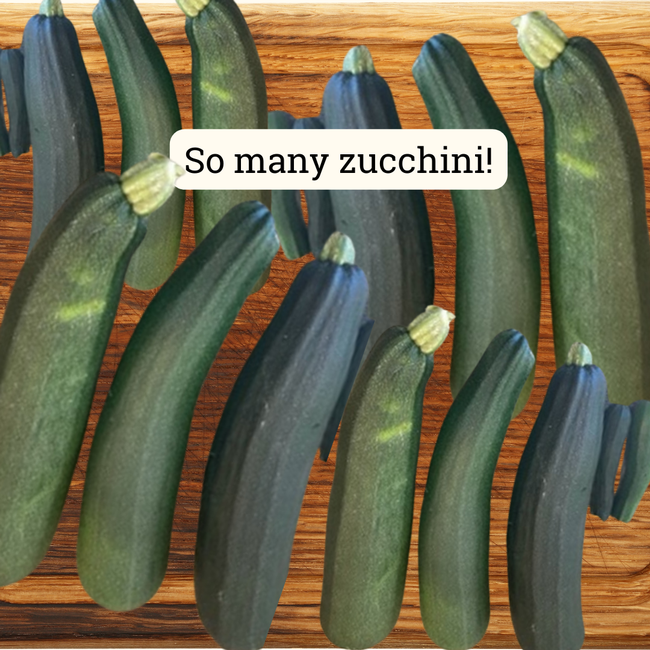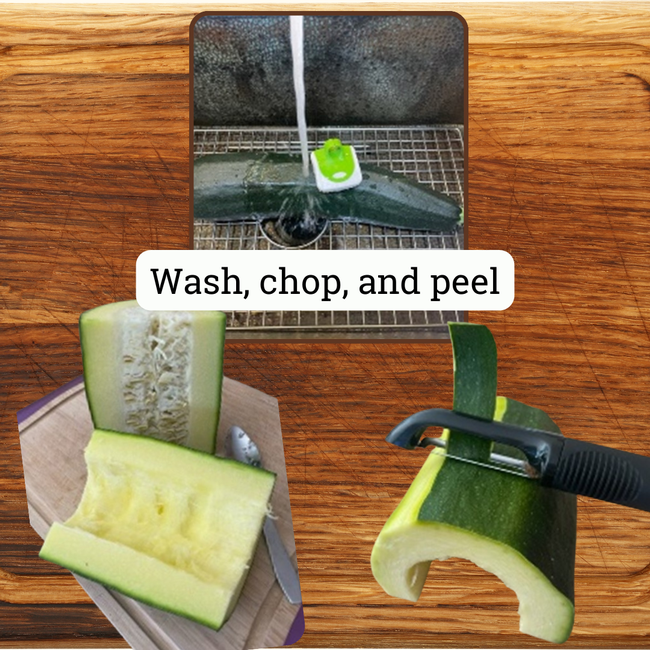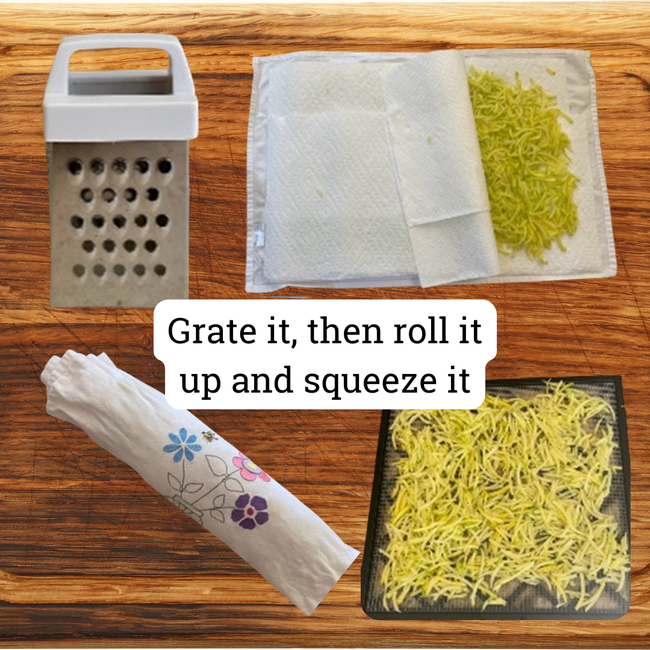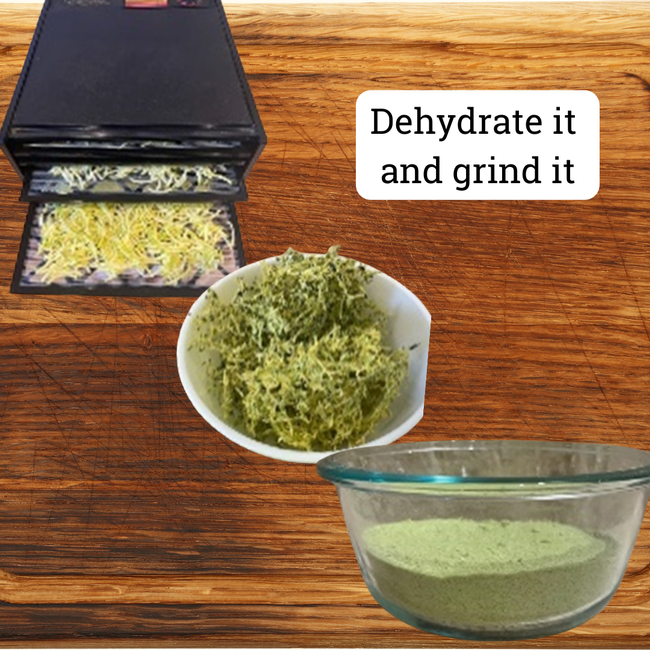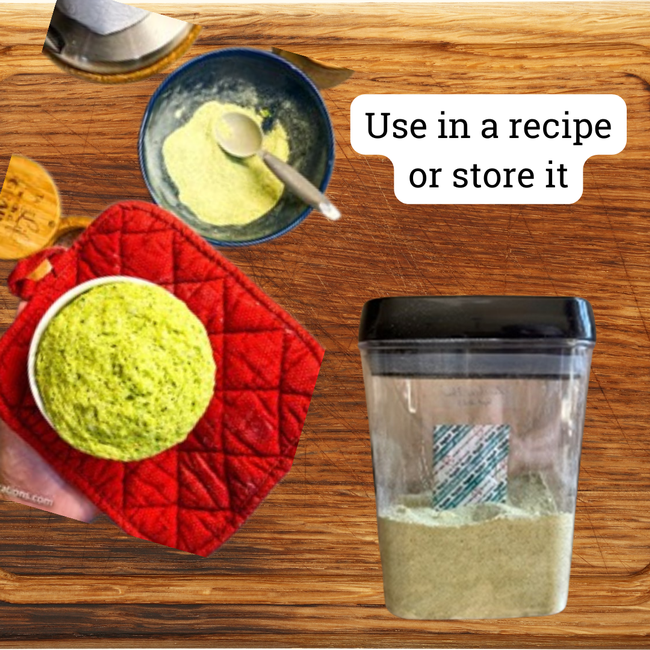Dehydrated Zucchini Flour
Lynn Pastusak, UC Master Food Preserver Volunteer
I went out of town for four days and came home to massive zucchini!! What was I going to do with these monsters? I hate to throw away good food, especially beautiful home grown food. Then I had an ah ha moment, I could make zucchini flour!
Zucchini flour? What's that? It's mild flavored and gluten-free. That sounds nourishing, I thought, and I can hide it in my recipes! I'd never done it, but it sounded like a fun project and a great way to keep a big zucchini in a small container.
The very first thing to do is make sure all your kitchen supplies and surfaces are scrubbed clean and sanitized. Is there a difference? Absolutely. Find more information here about cleaning, sanitizing and disinfecting. After everything is squeaky clean, scrub the zucchini with a vegetable brush under running cold water. Don't put the zucchini in a sink or bowl full of water. The germs and bacteria will just float around. The running water washes all the bad stuff down the drain.
Then cut the zucchini into manageable sizes and remove the seeds. I used a grapefruit spoon. Its little, sharp, serrated teeth worked perfectly and made the job of scraping out all those seeds and pulp easy.
Next, you will need to decide whether to pare or not to pare the zucchini. If you leave the peel on, the flour will be a bit greener in color. Also, the peel may be bitter. Taste the peel before you pare it and decide what is best for you. The peel was not bitter on my zucchini, but I wanted to see the color and texture difference of my flour. I'll show the results later.
Then, cut the zucchini into workable pieces and grate them using a handheld cheese grater - or if you have a rotary grater or electric grater, it will go a lot faster. I used my electric grater, and it was super fast!
Zucchini holds a lot of moisture. The wetter it is, the longer it will take to dry in the dehydrator so you will want to dry the grated zucchini as much as possible. You can do this by placing the grated zucchini in a colander for about 15 minutes and pressing down on it to squeeze out the liquid or by squeezing the grated zucchini with a potato ricer. Another way, and is how I did it, is to lay some paper towels on a cloth towel; place a layer of grated zucchini on the paper towels; place another layer of paper towels on top of the zucchini; roll the towel up tightly and squish with your hands to absorb the liquid.
After the zucchini has released enough liquid, preheat the dehydrator to 135°.
Place the drained grated zucchini on the dehydrator trays. The pieces are pretty thin, so you don't have to worry about spreading the grated zucchini out sparsely. It's ok if some are overlapping a bit. You might want to stir them gently after a couple hours of drying in case there are some patches not drying as quickly because they are overlapped and stuck together.
Heat the grated zucchini in the dehydrator. The University of Maine Cooperative Extension recommends heating zoodles, which is a type of grated zucchini, at 135° until the zucchini is very dry and crispy. It's difficult to determine the exact heating time as moisture in the air (humidity) has a major impact on drying time, but it should take about 7-11 hours.
Remove the dried grated zucchini from the dehydrator.
Now comes the fun part! Fill your blender, food processor, or chopper about 2/3 full with the dehydrated grated zucchini and grind it until it is finely ground. Any grinder will work. Some grind finer than others. I used my Vitamix and it ground it to a very fine consistency.* (Read the important note below before removing the lid.)
Congratulations! You've just made flour!
*Important! After you are done grinding, keep the lid on your grinder for a few minutes to let the dust settle. If you don't, you will have a cloud of zucchini dust puff out all over the place when you remove the lid. It can be quite messy and it's not good to inhale all those fine particles.
Remember, I mentioned that I wanted to experiment with leaving the peel on or off. I left the peel on the first batch and pared the second batch. It's difficult to tell with the photos, but there was a slight difference in color; the peeled zucchini was a pale green and the unpeeled zucchini was a bit darker green. I did not notice a difference in the texture or taste. Therefore, I just combined both flours into one container.
Store the zucchini flour in an airtight container, such as a mason jar with a tight-fitting lid. You can also vacuum seal the jar lids for longer lasting storage. The zucchini flour tends to pull moisture from the air which can cause clumping and molding. To prevent this, you may add a food safe silica packet to absorb the moisture. This is optional, but well worth it. You can read more about silica packets here.
Do not store the zucchini flour in the refrigerator. There is too much moisture in the refrigerator which will undo all your dehydrating work.
Use your beautiful zucchini flour within 6 months for best taste; however, it can be stored for up to 1 year, especially with a silica packet. Not sure if it is good? Smell it; it's no good if it smells musty. It's no good if it is wet and has large clumps of mold. Here's an article to tell you more about bad flour.
So, how much flour will you get? Roughly 3 ½ pounds of zucchini will make about 2 cups of dried shredded zucchini which will end up making a scant ½ cup of zucchini flour.
Now that you have successfully made the zucchini flour, what do you do with it? You can make cakes, breads, cookies, muffins, and quick breads that don't require a lot of rising time since there is no gluten in the zucchini flour. Zucchini flour can replace coconut flour (1:1 ratio). You can replace 1/4 to 1/3 cup of regular flour with the zucchini flour (1:3-4 ratio). (I've been told you might want to add 1-2 tablespoons additional water or oil and mix it extra well.) Try adding some of the zucchini flour to soups, stir fries, casseroles, smoothies, scrambled eggs, or pancake batters. Have fun and add color and nutrition by adding a bit (not a lot) when making pasta (1:10 ratio).
There are a variety of easy to make recipes using alternative flours, such as zucchini flour, available on food blogs. A quick Google search will turn up many options. Find a reliable source for recipes and have some fun experimenting in the kitchen!
